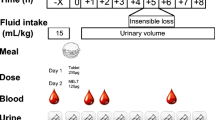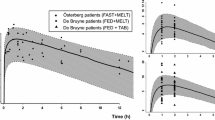Abstract
The objective of the present study was to investigate the pharmacokinetics (PK) and pharmacodynamics (PD) of desmopressin in healthy male subjects at different levels of overhydration. Also, we examined if an indirect-response model could be related to renal physiology and the pharmacological action of desmopressin. Eight healthy male subjects participated in this open, randomized crossover study with three periods. Each subject was orally water loaded (0 to 20ml·kg −1 body weight) on 3 study days in order to achieve three different levels of hydration. After the initial water load, urine was voided every 15 min and the volumes were measured. To ensure continuous overhydration the subjects replaced their fluid loss with drinking-water. When a steady-state diuresis was achieved after approximately 2 hr, 0.396 μg of desmopressin was administered intravenously as a bolus injection. Blood was sampled and urine was collected at intervals throughout the study day (10 hr). An indirect-response model, where desmopressin was assumed to inhibit the elimination of response, was fit to the urine osmolarity data. There were no statistically significant effects of different levels of hydration, as expressed by urine flow rate at baseline, on the estimates of the PK and PD model parameters. The calculated terminal half-lives of elimination (t1/2 β) ranged between 2.76 and 8.37 hr with an overall mean of 4.36 hr. The overall means of plasma clearance and the volumes of distribution of the central compartment (Vc ) and at steady state (Vss ) were estimated to be 1.34 (SD 0.35) ml·min −1 ·kg −1 , 151 (SD28) ml·kg −1 , and 386 (SD 63) ml·kg −1 , respectively. High urine flow rate, indicating overhydration, produced a diluted urine and thus a low osmolarity at baseline (R0 ). The effect of the urine flow rate on the urine osmolarity at baseline was highly significant (p<0.0001). The mean values for IC50 and the sigmoidicity factor (γ) were 3.7 (SD 1.2) pg·ml −1 and 13.0 (SD 3.5), respectively. In most cases when there was a high urine flow rate at baseline, the model and the estimated PD parameters could be related to the pharmacological action of desmopressin and renal physiology. Thus, the indirect-response model used in this study offers a mechanistic approach of modeling the effect of desmopressin in overhydrated subjects.
Similar content being viewed by others
REFERENCES
A. Robinson. DDAVP in the treatment of central diabetes insipidus. New Engl. J. Med. 294:507-511 (1976).
T. B. Matthiesen, S. Rittig, J. C. Djurhuus, and J. P. Norgaard. A dose titration, and an open 6-week efficacy and safety study of desmopressin tablets in the management of nocturnal enuresis. J. Urol. 151:460-463 (1994).
J.-L. David. Desmopressin and hemostasis. Regul. Pept. 45:311-317 (1993).
T. Callréus and P. Höglund. Pharmacokinetics and antidiuretic effect of intravenous administration of desmopressin in orally overhydrated male volunteers. Pharmacol. Toxicol. 83:259-262 (1998).
H. Vilhardt and S. Lundin. Biological effect and plasma concentrations of DDAVP after intranasal and peroral administration to humans. Gen. Pharmacol. 17:481-483 (1986).
T. Williams, D. Dunger, C. Lyon, R. Lewis, F. Taylor, and S. Lightman. Antidiuretic effect and pharmacokinetics of oral 1-desamino-8-D-arginine vasopressin. 1. Studies in adults and children. J. Clin. Endocrinol. Metab. 63:129-132 (1986).
S. Rittig, A. R. Jensen, K. T. Jensen, and E. B. Pedersen. Effect of food intake on the pharmacokinetics and antidiuretic activity of oral desmopressin (DDAVP) in hydrated normal subjects. Clin. Endocrinol. 48:235-241 (1998).
A. Sharma and W. Jusko. Characteristics of indirect pharmacodynamic models and applications to clinical drug responses. Br. J. Clin. Pharmacol. 45:229-239 (1998).
N. Holford and L. Sheiner. Understanding the dose-effect relationship: Clinical application of pharmacokinetic-pharmacodynamic models. Clin. Pharmacokin. 6:429-453 (1981).
N. Dayneka, V. Garg, and W. Jusko. Comparison of four basic models of indirect pharmacodynamic responses. J. Pharmacokin. Biopharm. 21:457-478 (1993).
W. Jusko and H. Ko. Physiologic indirect response models characterize diverse types of pharmacodynamic effects. Clin. Pharmacol. Ther. 56:406-419 (1994).
M. Wakelkamp, G. Alván, and G. Paintaud. The time of maximum effect for model selection in pharmacokinetic-pharmacodynamic analysis applied to frusemide. Br. J. Clin. Pharmacol. 45:63-70 (1998).
M. Hammer and H. Vilhardt. Peroral treatment of diabetes insipidus with a polypeptide hormone analog, desmopressin. J. Pharmacol. Exp. Ther. 234:754-760 (1985).
T. Callréus, J. Lundahl, A. Broeders, and P. Höglund. Pharmacokinetics and antidiuretic effect of a new vasopressin analogue (F992) in overhydrated male volunteers. Eur. J. Clin. Pharmacol. 55:293-298 (1999).
S. Lundin, P. Melin, and H. Vilhardt. Plasma concentrations of 1-deamino-8-D-arginine vasopressin after intragastric administration in the rat. Acta Endocrinol. 108:179-183 (1985).
G. Robertson. Regulation of vasopressin secretion. In D. Seldin and G. Giebisch (eds.), The Kidney. Physiology and Pathophysiology, Raven Press, New York, 1985, pp. 869-884.
E.K. Jackson. Vasopressin and other agents affecting the renal conservation of water. In J. G. Hardman and L. E. Limbird (eds.), Goodman and Gilman's: The Pharmacological Basis of Therapeutics, McGraw-Hill, New York, 1996, pp. 715-731.
E. Gebruers and W. Hall. Role of the gastrointestinal tract in the regulation of hydration in man. Digest Dis. 10:112-120 (1992).
Author information
Authors and Affiliations
Rights and permissions
About this article
Cite this article
Callréus, T., Odeberg, J., Lundin, S. et al. Indirect-Response Modeling of Desmopressin at Different Levels of Hydration. J Pharmacokinet Pharmacodyn 27, 513–529 (1999). https://doi.org/10.1023/A:1023238514015
Published:
Issue Date:
DOI: https://doi.org/10.1023/A:1023238514015




